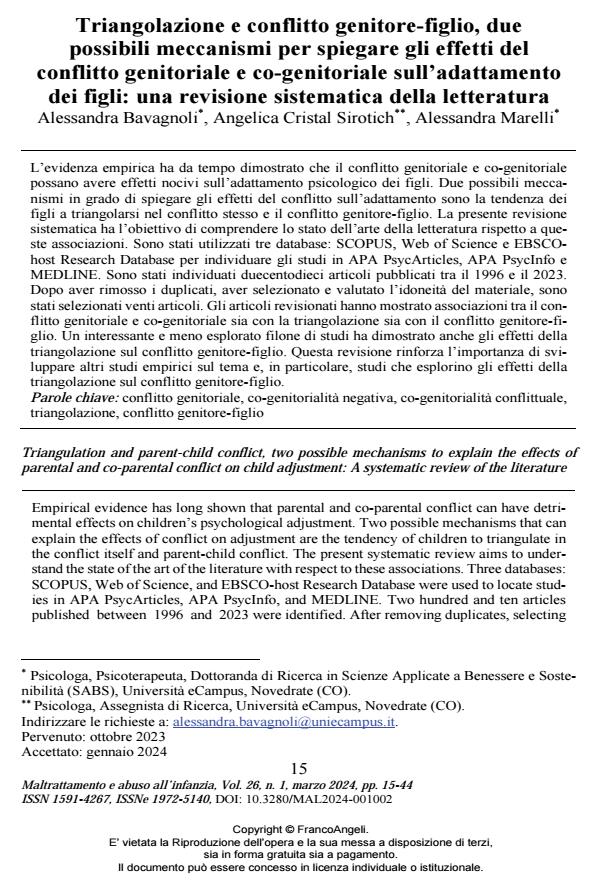Triangulation and parent-child conflict, two possible mechanisms to explain the effects of parental and co-parental conflict on child adjustment: A systematic review of the literature
Journal title MALTRATTAMENTO E ABUSO ALL’INFANZIA
Author/s Alessandra Bavagnoli, Angelica Cristal Sirotich, Alessandra Marelli
Publishing Year 2024 Issue 2024/1
Language Italian Pages 30 P. 15-44 File size 281 KB
DOI 10.3280/MAL2024-001002
DOI is like a bar code for intellectual property: to have more infomation
click here
Below, you can see the article first page
If you want to buy this article in PDF format, you can do it, following the instructions to buy download credits

FrancoAngeli is member of Publishers International Linking Association, Inc (PILA), a not-for-profit association which run the CrossRef service enabling links to and from online scholarly content.
Empirical evidence has long shown that parental and co-parental conflict can have detrimental effects on children’s psychological adjustment. Two possible mechanisms that can explain the effects of conflict on adjustment are the tendency of children to triangulate in the conflict itself and parent-child conflict. The present systematic re-view aims to understand the state of the art of the literature with respect to these asso-ciations. Three databases: SCOPUS, Web of Science, and EBSCO-host Research Da-tabase were used to locate studies in APA PsycArticles, APA PsycInfo, and MED-LINE. Two hundred and ten articles published between 1996 and 2023 were iden-tified. After removing duplicates, selecting and evaluating the suitability of the material, twenty articles were selected. The reviewed articles showed associations between parenting and co-parenting conflict with both trian-gulation and parent-child conflict. An interesting and less explored strand of studies also demonstrated the effects of triangulation on parent-child conflict. This review reinforces the importance of developing more empirical studies on the topic and, in particular, stud-ies exploring the effects of triangulation on parent-child conflict.
Keywords: parenting conflict, negative co-parenting, conflict co-parenting, triangulation, parent-child conflict
Alessandra Bavagnoli, Angelica Cristal Sirotich, Alessandra Marelli, Triangolazione e conflitto genitore-figlio, due possibili meccanismi per spiegare gli effetti del conflitto genitoriale e co-genitoriale sull’adattamento dei figli: una revisione sistematica della letteratura in "MALTRATTAMENTO E ABUSO ALL’INFANZIA" 1/2024, pp 15-44, DOI: 10.3280/MAL2024-001002